La Ruota della Fortuna/The Wheel of Fortune
Life isn’t fair. We’ve all experienced those times when things were humming along smoothly; we were in control; we had a plan and the goal was in sight. Then the wheel turned and everything fell to pieces. The ancient Greeks had a goddess for that – Tyche, balanced precariously on a ball in the middle of the ocean, embodying changeable luck. She’s often blindfolded because she dispenses good and bad fortune indiscriminately, regardless of whether the recipient is deserving or not.
Although images of Tyche were known in the Middle Ages, Lady Fortuna spinning helpless people on a wheel personified arbitrary fate in the medieval imagination. This Wheel of Fortune concept comes from The Consolation of Philosophy, written in 543 CE by Boethius. Artists reproduced this popular image in thousands of manuscripts as well as the earliest tarot decks.
Boethius was the golden boy of the late Roman empire who lost everything in a dramatic turn of the wheel. Born into an aristocratic Roman family in 480 CE, he received an excellent education, and by age thirty was rising quickly through the ranks of the imperial administration. In his spare time, he translated Aristotle and Plato from Greek into Latin, and wrote books on music, mathematics and medicine that became standard textbooks. His works are considered the foundation of medieval Christian ethics and logic. In the year 523, at age 43, he had gone as high as one can go in the imperial administration, becoming Master of Offices in the court of Theodoric, the Ostrogoth king who conquered Italy and ruled from Ravenna.
The following year, jealous enemies slandered Boethius and forged incriminating documents. His property was confiscated and he was imprisoned in Pavia, hundreds of miles from Ravenna. While in prison, far from friends and allies, tortured and about to be separated from his head, he wrote his classic book, The Consolation of Philosophy, on the Stoic-Christian way of meeting misfortune with a calm, detached mind.
Boethius’ concept of the Wheel of Fortune made its way into Arthurian romances, Dante, Chaucer, and numerous illuminated manuscripts. The Consolation of Philosophy was one of the first books published after the printing press was invented, and has never gone out of print.

In the first section of the book, after wallowing in self-pity for a time, Boethius has a vision of Lady Philosophy, his companion and teacher for the rest of the book. The left side of the image above shows the lady visiting a dejected Boethius in his prison cell and instructing him on the proper way to deal with bad luck. Here is her description of Fortuna (illustrated on the right panel above):
“Fortune, of course, is a monster and she toys with those for whom she intends catastrophe, showing her friendly face and lifting them up before dashing them down when they are least prepared for it. … Anything you had from her hands was not worth having and in losing those things you have lost nothing of importance.”
“With an indifferent hand she spins the wheel and one or another number comes up lucky, while the only constant is change.”
Lady Philosophy quotes Fortuna: “I have a wheel and I turn it so that what is low is raised high and what is up is brought down. You ascend? Fine! But you must acknowledge that it can’t be wrong for you to have to descend again. You were not unaware of how the wheel works.”
“What else is tragedy but the sad story of happy men who are overthrown by the blows of Fortune”?
Throughout the book, Lady Philosophy emphasizes that only a fool would base his happiness on grasping for wealth or high office. If you do, you have only yourself to blame when Fortune does what comes naturally to her and takes it all away. A Christian should know that it’s folly to chase after worldly pleasures and ambitions that distract one from focusing on God. A Christian also knows that God is the ultimate power behind the spinning wheel. Your good or bad fortune is not random. A wise person is able to step off the spinning wheel and take consolation in knowing that their small misfortunes are part of God’s larger plan for the universe.
Boethius didn’t describe the Wheel of Fortune explicitly, but medieval artists quickly settled on a conventional depiction that persisted with minor variations for centuries. The characters spinning on the wheel were usually kings. Sometimes they represented the three estates of man: peasant, clergy, and noble; occasionally they were animals. Sometimes the wheel depicted the human life cycle, or personified the seven planets. The person at the bottom of the wheel might be clinging to it, or he could be on the ground crushed under the wheel. Lady Fortuna might be next to the wheel cranking it, or in the center spinning the wheel with her hands.
The earliest tarot Wheels of Fortune appear on hand-painted, gilded cards commissioned by the rulers of Milan in the mid-15th century. On the card shown here, made for the Duke and Duchess of Milan, we see three small, rather child-like figures on the wheel and an old man beneath it. The ascending figure may have asses’ ears like the figure on top; or he may be wearing feathers like the Fool in this deck. Either way, he demonstrates the absurdity of clawing ones’ way to the top of the wheel when a fall is inevitable.
All four people on this card have ribbons near their heads proclaiming their position on the wheel. This is not unique to tarot – there are many precedents in early medieval manuscripts. The ascending figure on the left says Regnabo “I will reign.” The figure on top says Regno “I reign.” The descending figure says Regnavi “I have reigned.” The figure on the bottom says Sum Sine Regno “I am without reign.” Bringing this up-to-date, we can see a corporate executive or a politician climbing up the ladder until he reaches as high as he can go. Inevitably, younger, hungrier rivals will come up behind him and push him off the pinnacle. Even if that doesn’t happen, he’ll inevitably be rendered irrelevant by forced retirement, sickness or death, which are illustrated in neighboring cards of the trump sequence.
Early Italian and French Wheel of Fortune Cards
The people clinging to the Wheel gradually evolved to be more animal-like. This trend was accelerated by a popular illustrated book, The Ship of Fools (Das Narrenshiff or Stultifer Navis) by Sebastian Brant. The book consists of 122 woodcuts depicting the follies and vices of church and society. It was published in Switzerland in 1494 and became an immediate best-seller. One of these woodcuts depicts a Wheel of Fortune (shown at left).
The top figure on the wheel is entirely animal, since only an ass believes he’s found permanent security in that precarious situation. The descending figure on the left wears a fool’s cap with bells while his bottom half is animal. The ascending figure is reversed – his top half is a donkey, because the closer he gets to the top, the more asinine he becomes. The crank that spins the wheel descends from a cloud in the top left corner.

C. 1500

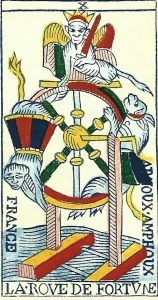
The three cards above show the evolution of the Wheel of Fortune card. The Italian card on the left is similar to the Visconti-Sforza version, while exhibiting influences from the same source as the Ship of Fools. The four people on the wheel have speech ribbons with the same words as the Visconti-Sforza figures. As in the Ship of Fools, the figure at the top of the wheel is entirely animal, possibly a donkey, while the ascending figure on the right, who aspires to the top place, already has an animal’s head. No one spins the wheel, which is typical of cards printed after 1500.
The center card is one of the oldest in the Tarot de Marseille pattern. The ascending figure has become even more donkey-like. The descending figure wears a pleated skirt, and his flared tail was gradually changed to a torch by some later publishers. The wheel is surmounted by a king with a crown, baton and flaring cloak that is sometimes interpreted as wings. His time on the wheel has paid off with worldly fame and fortune, at least for now. He could also be an absolute monarch who can elevate you or destroy you on a whim.
The card on the right shows how the Tarot de Marseille pattern evolved over 150 years. The top figure still has the regal crown, sword and cape, but has lost his human features and seems to be a composite animal. The wheel is resting on water, referencing the precariously balanced Greek Tyche.
Traditional Divinatory Meanings
In a reading, the card tells you a change in your luck is coming. Thanks to Etteilla’s influence, it usually means a change for the better. You’re enjoying success due to luck, not your own hard work or talent; but the situation is unstable and the good fortune won’t last.
While the Tarot de Marseille image has remained essentially the same for the past 350 years, an esoteric and spiritualized version of this card emerged in the mid-nineteenth century, creating an alternate tradition that led to the Waite Smith Wheel of Fortune.
The Occult Wheel of Fortune Card
Eliphas Levi
Levi’s 1856 book Transcendental Magic made tarot an integral part of the western magical tradition and laid the foundations for twentieth century esotericism. Levi based his designs for the major arcana on the Tarot de Marseille, while incorporating elements of Kabballah and Egyptian myth. Here is how he describes the Wheel of Fortune:
“…the cosmogonical wheel of Ezekial, with a Hermanubis ascending on the right, a Typhon descending on the left and a sphinx in equilibrium above, holding a sword between his lion’s claws.”
Since Levi’s symbols reappear in many later decks, let’s unpack them.
Ezekial’s Wheel appears in Ezekial chapter 10 of the Bible, which describes the vision of a Jewish priest during the Babylonian captivity. Ezekial saw in the sky four sets of four wheels within wheels, sitting at right angles to each other, and covered with eyes, so they could move in any direction in response to God’s will. These wheels accompany four cherubim with four faces each – that of a man, cherub, lion, and eagle. These creatures also appear in Revelations Chapter 4 verse 7, surrounding a throne in the sky. The early church associated these figures with the four evangelists: Matthew, Mark, Luke, and John, but changing the man to an ox. They were also associated with the four fixed signs of zodiac: Leo, Scorpio, Aquarius, and Taurus, as well as the four elements: earth, air, fire and water. They also appear in the four corners of the Tarot de Marseille and later World cards.
Hermanubis was a hybrid god who was popular in Egypt during the Hellenistic and Roman eras. He combines the Greco-Roman god Hermes with Egyptian Anubis, deities who conduct the souls of the dead to the Underworld. Hermanubis is usually depicted as a jackal-headed Hermes wearing a toga and holding a caduceus. In spite of Levi’s written description, the ascending figure on his wheel and is more like the Ship of Fools figure with a donkey’s head on a man’s body. It differs from the Tarot de Marseille ascending figure which is completely animal.
The fearsome monster Typhon was created by the Titans to destroy the Olympian gods. Its one hundred fire-breathing heads emitted a screeching sound, and it was seen as embodying destruction and evil. Levi’s descending figure doesn’t resemble Typhon; rather it looks like a conventional embodiment of evil, the Devil with horns and a trident.
Levi’s sphinx wears the pharaoh’s striped headgear that indicates his divine status. Its body combines the angel, eagle, lion and ox of Ezekial’s vision.
Levi simplified his wheel from Ezekial’s four wheels to two concentric circles resting on a moon-shaped boat that floats either on water or on a cloud. This unstable foundation refers to Fortuna balancing unsteadily on a ball or a boat in the ocean.
Oswald Wirth Tarot
The French occultist Oswald Wirth (1860-1943) had an immense influence on tarot that continues today. His Wheel of Fortune card is nearly identical to Levi’s. Hermanubis holds Hermes’ winged staff while the astrological symbol for Mercury floats above his head. The Sphinx combines the animals of Ezekial’s vision: a human body with the ox’s hindquarters, the lion’s tail and claws, and the eagle’s wings. Alchemical symbols float above its head.
In his writings, Wirth explains that the ascending figure is creation and good while the descending is pure evil and destruction. The Sphinx is the balance between the two poles. The wheel rests in the ocean on a red moon that Wirth associates with Isis. The red and green snakes transform the wheel’s shaft into Hermes’ caduceus, and are the male-female polarity that turns the wheel. A crank for turning the wheel is prominent, as with most Tarot de Marseille cards, but no one actually turns it. The symbolism of the animals clinging to the wheel is the point of the design, not the wheel’s motion.
Waite Smith Tarot
The Sphinx is the only thing this card has in common with the Levi/Wirth Wheel of Fortune. Waite broke with his fellow occultists by saying there was no connection between tarot and ancient Egypt or Kaballah; but it’s acceptable to use those symbol systems as long as you don’t imply they have anything to do with tarot’s origins.
Waite’s wheel is a solid disk with a sigil in the center and alchemical symbols on the spokes. The letters T A R O are inscribed around rim with the Hebrew letters of the name of God in between, reminding us that God’s will is the driving force behind all fluctuations of fate.
Waite’s descending figure is a rather anemic-looking snake which he called Set, an Egyptian deity who embodies evil. The snake may also refer to the Garden of Eden. Anubis ascending on the right is depicted as the Egyptian underworld god with no reference to Hermes. Waite said the Sphinx is the resurrected Egyptian god Horus who represents the triumph of life over death as well as wisdom and stability in the midst of constant fluctuation. The four creatures of Ezekial’s vision sit in the corners, as they do in the World card. Their books link them to the four evangelists.
This wheel floats in the clouds with no solid support and no crank to turn it. It’s in another dimension, a container for Waite’s symbol system, disassociated from human concerns.
The Modern Wheel of Fortune
Boethius and his medieval wheel warn us not to put our faith in things like money, fame or social status. Since God spins the wheel, you can only rely on spiritual values; worldly attachments will inevitably let you down.
These days, we like to think we are masters of our fate, not the victims of supernatural forces we can’t control. Getting this card in a reading may tell us that a surprising change is coming up, but we can pull other cards to tell us how to cope with the change, or how to stop the wheel from turning so we can create the destiny we want. Rather than an inevitable disaster, the turn of the wheel can be an initiation into a new beginning.

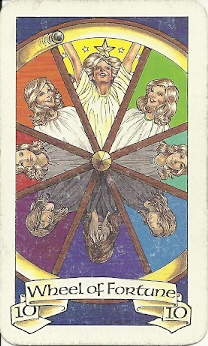
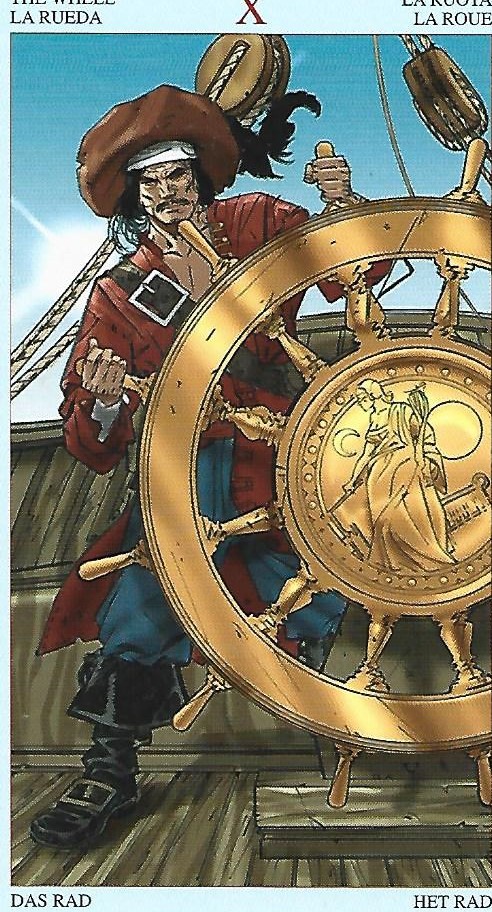
We like to think we’re in control, but inevitably, stuff happens; and it can make us feel as helpless and disoriented as the poor fellow in the Halloween card. Small random events, like a flat tire on the way to a job interview, can send our lives spinning toward an alternate destiny. Sometimes our little lives are overwhelmed by global events like wars, pandemics and extreme weather. How much control do we really have over our fate?
Perhaps due to the New Age belief in reincarnation, and the neo-pagan focus on the cycle of seasons, this card is often associated with repetitive cycles, including cycles of reincarnation. The Robin Wood card shows someone cycling repetitively through the same emotions. The artist calls this the “emotional roller coaster” card. It warns us that we’re stuck in a rut, doomed to make the same mistakes over and over again until we get some perspective and detach ourselves from the wheel.
Medieval Christians like Boethius were advised to disentangle themselves from the material world, accept their misfortunes as part of God’s plan, and have faith that whatever happens is for the greater good. Since we have more tools for controlling our destiny, and are less at the mercy of natural forces than our medieval ancestors, we take a more pro-active attitude toward fate. Rather than wallowing in victimhood, we try to take back control and create the life we want. The ship’s captain in the Pirate’s Tarot is not surrendering to the wind and ocean currents. He has seized the wheel and is using all his strength to keep the ship on course. But the figure of Fortuna in the center of the wheel is a reminder that we are never in complete control of our destiny, even when we think we’re the captain of our ship.
Summary
This card prompts us to look at where we are on the spectrum of possible meanings. Are we overwhelmed by powerful forces controlling our life? Do we feel that higher powers have it in for us and we’ll never get a break? Are we at the mercy of emotions and blind spots that keep us making the same mistakes over and over? Or, do we see ourselves sitting on top of the wheel, in total control, arrogantly immune to the disasters that bedevil lesser people? The ship’s captain shows a middle course. Have a destination in mind, and a course mapped out. Control the wheel, but have the flexibility to change course in response to emergencies and setbacks.
See more cards and art at Tarotwheel.net
Journey Through the Trumps Home
Next Page – The Hanged Man
List of images
- Wheel of Fortune. Illustration from The Garden of Delights. Herrad of Landsburg. 12th century.
- Philosophy Consoling Boethius and Fortune Turning the Wheel. Illustration from the Consolation of Philosophy, French 1460-1470. The Coetivy Master. J. Paul Getty Museum Collection.
- Wheel of Fortune from The Troy Book, John Lydgate, c. 1457. British Museum.
- Roman de la Rose, Illuminated manuscript. Bibliothèque Nationale Française, 380 fol. 36v.
- I Tarocchi Visconti Sforza. Milan c.1450. Reproduced by Il Meneghello, Milan, 2002. Collection of Pierpont Morgan Library, New York City.
- Ship of Fools (Stultifera Navis) (Das Narrenschiff). Sebastian Brant. Illustrations attributed to Albrecht Durer. Published by Johann Bergmann von Olpe, Basel, 1494.
- Budapest Tarot, late 15th century. Recreated by Sullivan Hismans, Tarot Sheet Revival, 2017. Collection of the Museum of Fine Arts, Budapest and the Metropolitan Museum of Art, New York.
- Jean Noblet Tarot, Paris c. 1650. Restored by Jean-Claude Flornoy, 2007. Collection of Bibliothèque Nationale Française, Paris
- Tarot Arnoux & Amphoux. Marseille, 1801. Restored by Yves Reynaud, 2018. Private Collection.
- Eliphas Levi. Wheel of Fortune illustration. La Clef des grands mysteres, 1861. Accessed at http://www.Anne-marie.eu.
- Ezekial Wheel. Found online with no attribution
- Greco-Roman statue. Vatican Museum.
- Oswald Wirth Tarot, 1887. Collection of the Bibliothèque Nationale Française, Paris.
- The Centennial Waite Smith Tarot Deck. London, 1909. U.S. Games System, Inc., Stamford, CT, 2009.
- Halloween Tarot. Kipling West. U.S. Games Systems, Stamford, CT, 1996.
- The Robin Wood Tarot. Robin Wood. Llewellyn Publications, 1991
- Pirates Tarot. Bepe Vigna. Lo Scarabeo, 2007.
Bibliography
Boethius, Anicius Manlius Severinus. The Consolation of Philosophy. Translated by David R. Slavitt. Harvard University Press, 2008, pages 29, 32, 33.
The Consolation of Philosophy was written in short sections that alternated prose passages with poetry that was meant to be sung. Early music expert Benjamin Bagby of Cambridge University, with the musicians of Sequentia, have recreated the medieval sound of the music.
https://www.youtube.com/watch?v=Ih2p_NiiwsU&list=RD2keTQlAs2co&index=2
See the separate Bibliography for books that discuss all the trump cards.



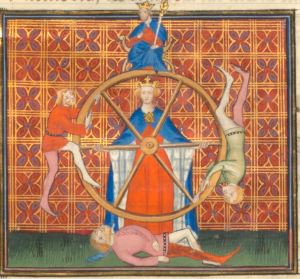



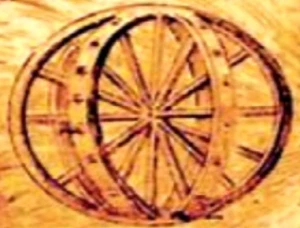

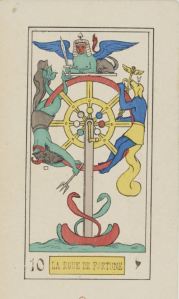


Visconti Sforza
Seasons come & seasons go
As Fortune’s wheel purports to show
No fixed position shall be found
On that which turns forever round
But at the centre of this wheel
Lies a place completely still.
Wonderful poem. You captured the essence of the card.